Air pollution may adversely affect female fertility

New research demonstrates that ovarian reserve, a potential indicator of female fertility, may be negatively impacted by levels of particulate matter and air pollution.
A new large-scale study has found high levels of particulate matter and air pollution to negatively impact ovarian reserve. Ovarian reserve is a measure of viable follicles resting within a female’s ovaries; it can be used as an indicator of female fertility.
The Ovarian Reserve and Exposure to Environmental Pollutants (ORExPo) study, assessed anti-Müllerian hormone (AMH) levels in 1318 Italian females. AMH is released by cells in the ovaries and is a widely accepted, circulating indicator of ovarian reserve.
Antonio La Marca, first study investigator from the University of Modena and Reggio Emilia (Modena, Italy), stated: “The influence of age and smoking on AMH serum levels is now largely accepted…but a clear effect of environmental factors has not been demonstrated so far.”
Researchers assessed the AMH levels of women living in Modena between 2007 and 2017 that had been assembled into a database. Serum AMH levels — measured in routine blood tests – were linked to subject’s age and residential address via a computing data warehouse. Residential addresses were used to estimate a ‘geo-localization’ environmental effect on participating individuals.
Measurement of environmental exposure effect on subjects evaluated individual’s daily particulate matter (PM) and nitrogen dioxide (NO2) levels.
As expected, the results of the study found that AMH levels in women over the age of 25 were significantly inversely related to the subject’s age.
The data also suggest that AMH levels are significantly, inversely correlated to environmental pollutant levels. These were defined as PM10 — particulates with a diameter up to 10 microns in length -, PM2.5 – particulates with a diameter up to 2.5 microns in length- and NO2. This link was independent of patient’s age.
The data were separated into quartiles based on the levels of PM10, PM2.5 and NO2 patients were exposed to. Significantly lower AMH levels were noted in subjects in the fourth quartile, compared to those from the first quartile.
Lowest levels of AMH were observed in subjects exposed to PM10, PM2.5 and NO2 levels of 29.5, 22 and 26 mcg/m3 respectively, even though these PM and NO2 levels are below the EU-recommended upper limits of 40, 25 and 40 mcg/m3 respectively.
La Marca commented that the data suggest that “…exposure to high levels of PM10, PM2.5 and NO2 increases the risk of having a severely reduced ovarian reserve by a factor between 2 and 3.”
The results add high levels of air pollution to the list of factors known to significantly impact on circulating AMH levels — currently including age, smoking status and body weight.
Source:
https://www.eshre.eu/ESHRE2019/Media/2019-Press-releases/La-Marca
